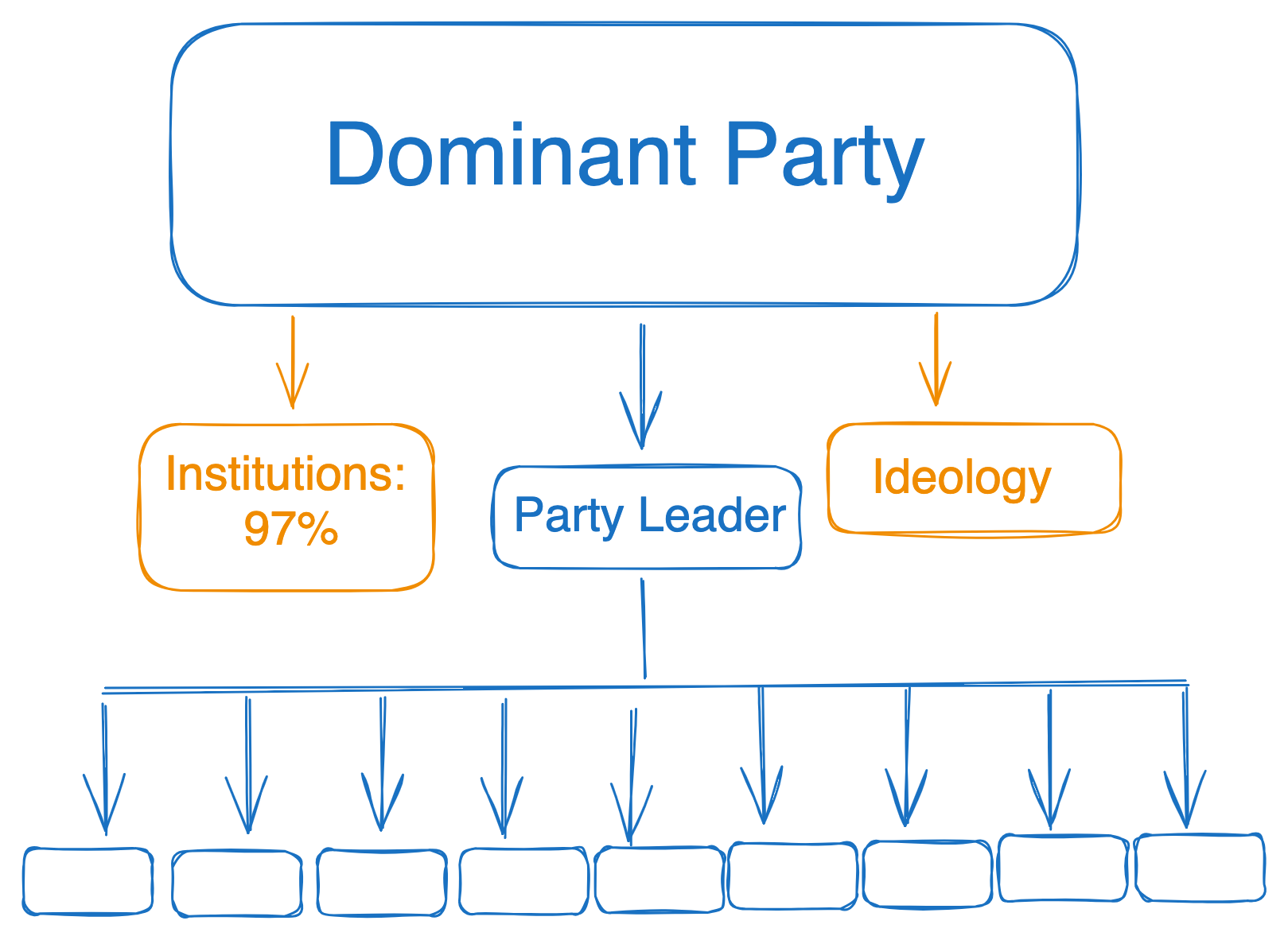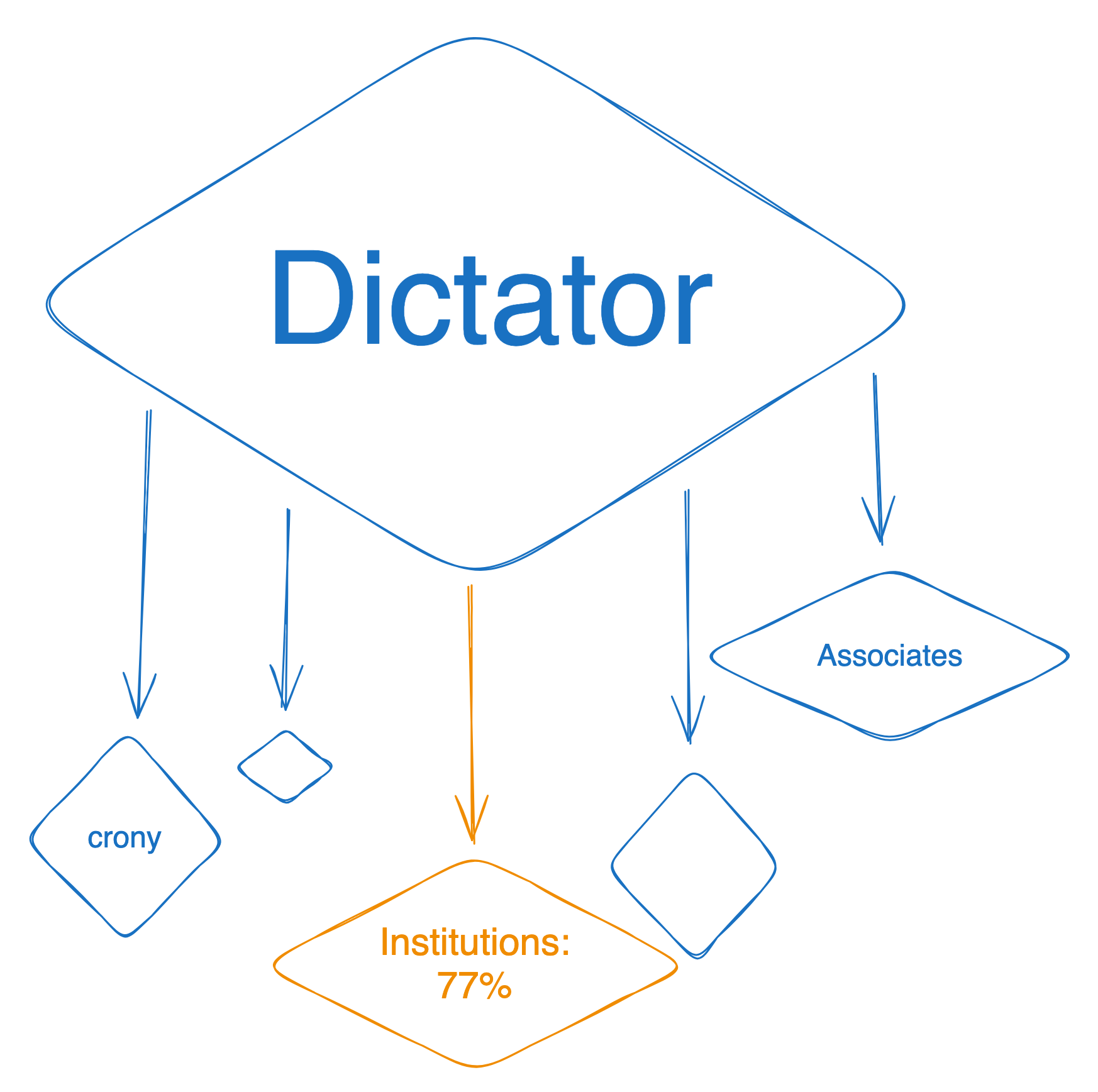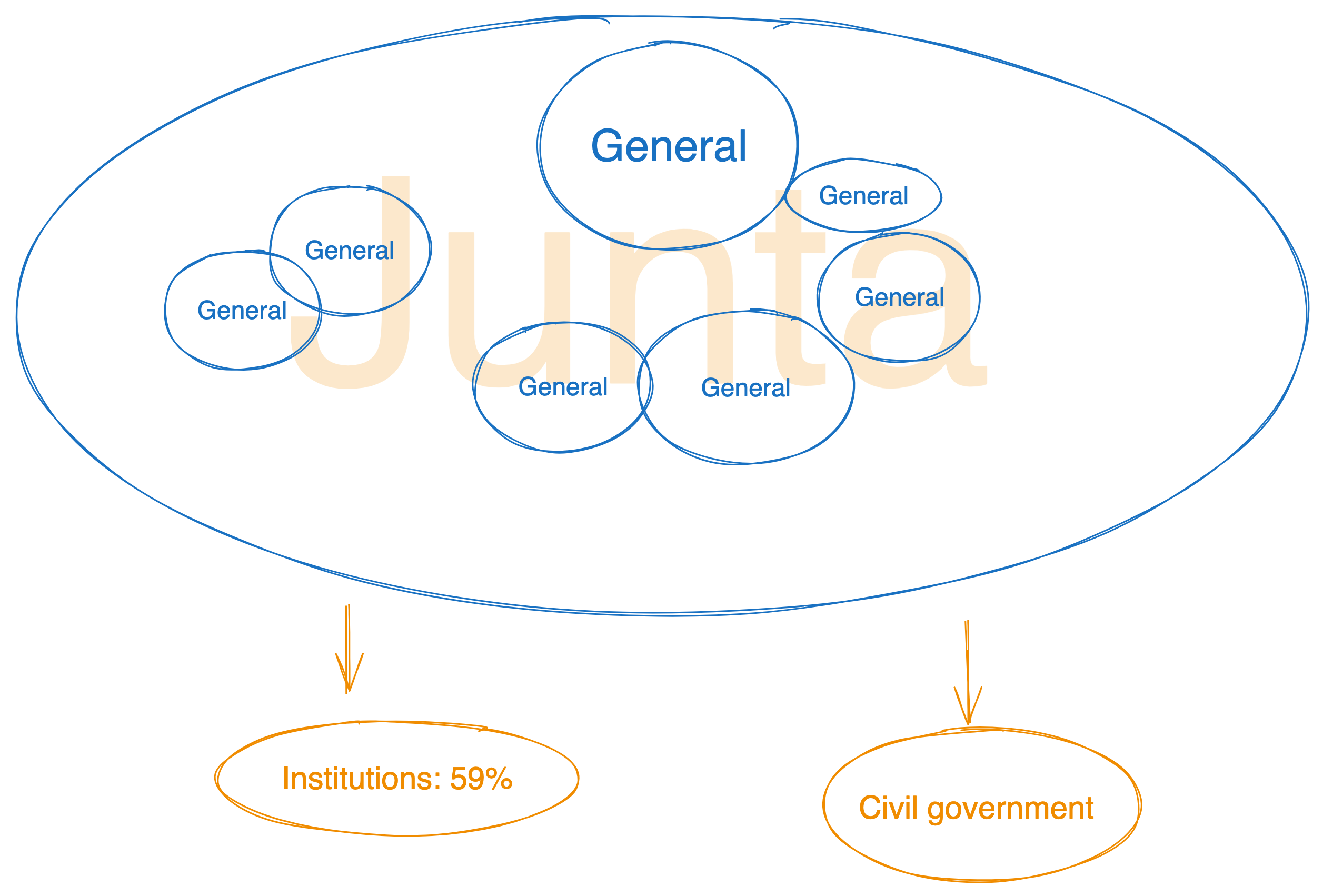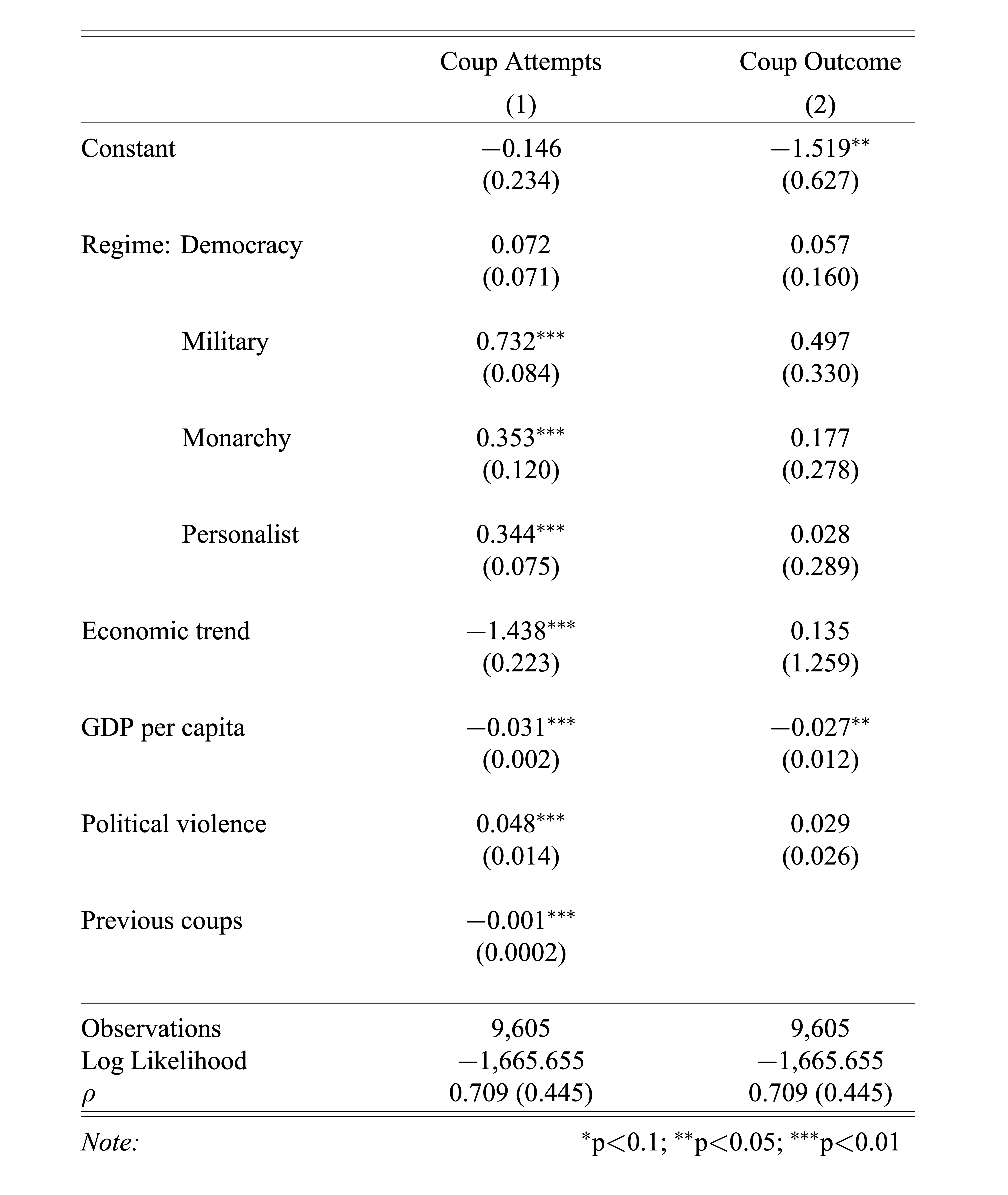| Country | Coup Attempted | Coup Succeeded | Success Rate |
|---|---|---|---|
| Bolivia | 23 | 11 | 47.8% |
| Argentina | 20 | 7 | 35.0% |
| Sudan | 17 | 6 | 35.3% |
| Haiti | 13 | 9 | 69.2% |
| Venezuela | 13 | 0 | 0.0% |
| Iraq | 12 | 4 | 33.3% |
| Syria | 12 | 8 | 66.7% |
| Thailand | 12 | 8 | 66.7% |
| Ecuador | 11 | 5 | 45.5% |
| Burundi | 11 | 5 | 45.5% |
| Guatemala | 10 | 5 | 50.0% |
| Total | 491 | 245 | 49.9% |
| Source: GIC dataset | |||
Prospective Impact of Expected Coup Outcomes on Coup Attempts: A Selection Mechanism Analysis
2024-05-31
1 Introduction
1.1 Research Question
Why are coups more frequent in some countries than in others?
1.2 Review of Previously Proposed Variables





About one hundred potential determinants of coups have been proposed, but no consensus has emerged on an established baseline model for analysing coups.
– When to expect a coup d’e ́tat? An extreme bounds analysis of coup determinants (Gassebner, Gutmann, and Voigt 2016, 293)
1.3 Drawbacks of Previous Studies
All the variables used in previous studies focus on pre-coup conditions, with no consideration given to post-coup factors.
However, coups are high-stakes gambles with an all-or-nothing nature. No coup plotters would stage a coup without some assurance of success.
Therefore, the expected outcome of a coup attempt is a crucial determinant of whether a coup is attempted.
2 Dynamics of coup attempts and outcomes
2.1 Coup success
The expected payoff of coups can be represented by the equation:
\[ E(U) = p \times B + (1 - p) \times (-C) \]
The condition for staging a coup is when the expected benefit is positive, meaning that the expected pay-off is greater than 0. Rearranging the equation, we get:
\[ p \times B > (1 - p) \times C \]
B and C are difficult to capture and measure, but we can consider them equally significant. Therefore, we can omit them and focus our attention on \(p\):
\[ p > (1-p) \]
Table 1 presents the top 10 countries of coup attempts and their success rates. Notably, the average success rate of these coup attempts is approximately 50%.
2.2 But what does the success rate of coups imply?
If we focus on the success rate, we might identify the determinants that truly impact coup attempts and avoid dwelling on less relevant factors.
So, what could most significantly influence the success rate of coups? The answer lies in the balance of power within the ruling elites.
What determines this balance of power? The types of regimes.
2.3 Regime types and power dynamics
According to Geddes, Wright, and Frantz (2014) (GWF), autocratic regimes can be categorized into three broad types based on leadership origins and decision-making factors:
Military Regimes: A group of military officers controls the regime’s power structure, including leadership selection and policy formulation.
Personalist Regimes: Absolute power rests with a single dictator.
Dominant-Party Regimes: Supreme power resides within the ruling party, with the leader acting as its representative and subject to its collective leadership.
| Regime Type | Country Year | Share | Num of Coups | Percent of Coups | Coup Likelihood |
|---|---|---|---|---|---|
| Democracy | 5303 | 46.7% | 122 | 24.8% | 2.3% |
| Dominant-Party | 2569 | 22.6% | 82 | 16.7% | 3.2% |
| Personal | 1477 | 13.0% | 113 | 23.0% | 7.7% |
| Monarchy | 1056 | 9.3% | 25 | 5.1% | 2.4% |
| Military | 638 | 5.6% | 110 | 22.4% | 17.2% |
| Other | 322 | 2.8% | 39 | 7.9% | 12.1% |
| Total | 11365 | 100.0% | 491 | 100.0% | 4.3% |
| Source: REIGN and GIC Datasets | |||||
Table 2 presents the regime types and their likelihood of experiencing coups. It is noticeable that military regimes have the highest likelihood of coups, followed by personalist regimes, with the exception of the “Other” category.
2.4 Why military regimes are most prone to coups, followed by personalist regimes?
2.5 Hypotheses
H1: The primary determinant of a coup attempt is the perceived chance of success. Coup plotters likely require a success threshold of at least 50%.
H2: Due to their balance of power dynamics, military regimes are more prone to coups, followed by personalist regimes, while dominant-party regimes are the least likely to experience coups among the three.
3 Research Design
3.1 Double probit with sample selection model
| Regime Type | Country Year | Share | Num of Coups | Percent of Coups | Success Rate | Coup Likelihood |
|---|---|---|---|---|---|---|
| Democracy | 5303 | 46.7% | 122 | 24.8% | 51.6% | 2.3% |
| Dominant-Party | 2569 | 22.6% | 82 | 16.7% | 53.7% | 3.2% |
| Personal | 1477 | 13.0% | 113 | 23.0% | 44.2% | 7.7% |
| Monarchy | 1056 | 9.3% | 25 | 5.1% | 56.0% | 2.4% |
| Military | 638 | 5.6% | 110 | 22.4% | 48.2% | 17.2% |
| Other | 322 | 2.8% | 39 | 7.9% | 53.8% | 12.1% |
| Total | 11365 | 100.0% | 491 | 100.0% | 49.9% | 4.3% |
| Source: REIGN and GIC Datasets | ||||||
Table 3 shows the regime types and success rates. It is evident that the success rates in different regime types are quite close.
Double probit with sample selection model (continued)
The similar success rates cannot be due to chance.
Coup attempts are self-selected events.
-
Therefore, a double probit model with sample selection is more appropriate.
- The first stage (selection equation) examines the probability of a regime experiencing a coup attempt.
- The second stage (outcome equation) evaluates the probability of the success of those coups.
3.2 Variables
Dependent variables: Coup attempt and coup success.
-
Independent variables:
- Regime type
- Economic performance:
- GDP per capita level
- GDP per capita growth trend
- Political violence
- Number of previous coup attempts
4 Results and discussion
4.1 Results
4.2 Conclusion
The direction and significance of the coefficients align with theoretical expectations. Due to distinct internal power dynamics, Military and personalist regimes, are more likely to experience coup attempts compared to dominant-party regimes, holding other factors constant.
Better economic conditions not only reduce the likelihood of coup attempts but also decrease the likelihood of coup success.
Thanks for your attention!
Comments and suggestions are welcome!
5 References




